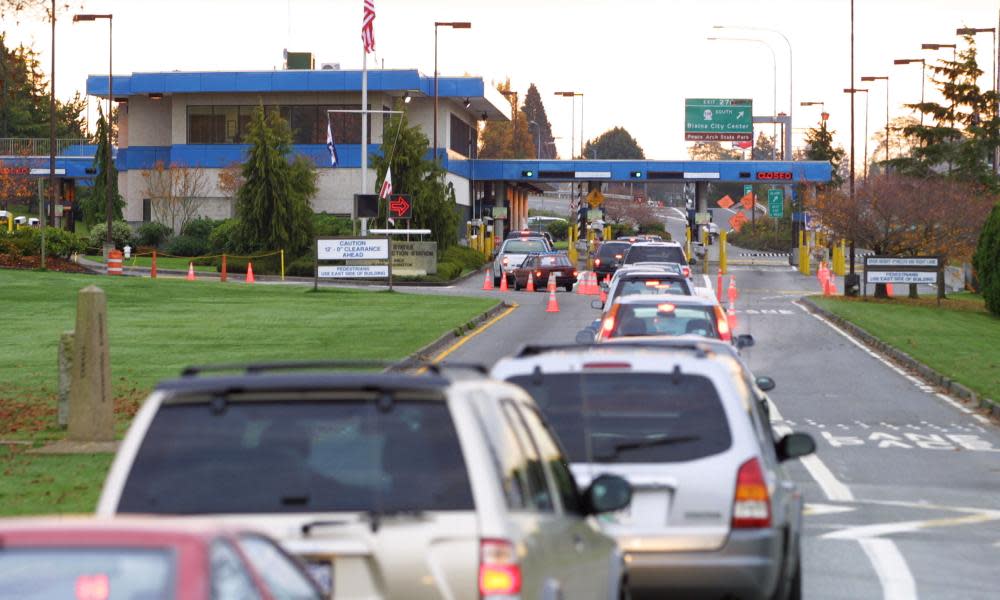Jogger accidentally crosses US border from Canada and is held for two weeks

It started as a leisurely jog along a Canadian beach on a cool spring evening. But it turned into a two-week nightmare after Cedella Roman accidentally veered across the US border and was seized by US border patrol agents.
The French citizen was visiting her mother and studying English, when the family headed to White Rock, about an hour’s drive from Vancouver in May.
As dusk approached, the 19-year-old went for a jog along the beach. She swerved on to a dirt path as the tide came in, stopping briefly to snap a photo of the stunning scenery before turning around to retrace her steps.
It was then that she was confronted by two officers from the US border patrol.
“An officer stopped me and started telling me I had crossed the border illegally,” Roman told Radio-Canada. “I told him I hadn’t done it on purpose, and that I didn’t understand what was happening.”
She hadn’t seen any signs marking the border, she said. “I said to myself, well I may have crossed the border but they’ll probably only give me a fine, or they’ll tell me to go back to Canada or they’ll give me a warning.”
Complicating matters was the fact that she didn’t have any government-issued ID or travel permits on her at the time.
Noting that her steps had been captured on security cameras monitoring the area, the officers detained the teenager and accused her of crossing illegally into Blaine, Washington.
She was transferred to the Tacoma Northwest Detention Centre, run by the Department of HomelandSecurity, more than 200km (125 miles) south of where she had been apprehended.
How big is the force?
Already the largest and most funded federal law enforcement agency in its own right, the border patrol is part of the umbrella agency US Customs and Border Protection (CBP). CBP’s approximately 60,000 employees are split in four major divisions: officers who inspect imports; an air and marine division; agents who staff ports of entry – international airports, seaports and land crossings; and the approximately 20,000 agents of the border patrol, who are concentrated in the south-west, but stationed nationwide.
What are its powers?
The border patrol enjoys extraordinary police powers. Agents operate checkpoints where they stop motorists everyday without suspicion, and in the interior of the country up to 100 miles, they can board planes, trains and buses. There is no geographic limit to which agents can otherwise conduct stops amid roving patrols, though they are technically required to have reasonable suspicion to do so. Extending from not only land borders but also the Pacific, Atlantic, Gulf and Great Lakes coasts, the 100-mile zone encompasses two out of every three Americans, 12 states in their whole or near entirety and nine of the 10 biggest cities in the nation.
“They put me in the caged vehicles and brought me into their facility,” said Roman. “They asked me to remove all my personal belongings with my jewelry. They searched me everywhere.”
The gravity of the situation began to sink in. “I understood it was getting very serious and I started to cry a bit.”
Roman was able to contact her mother from the centre. Christiane Ferne rushed to the facility in a panic, bringing with her Roman’s passport and study permits.
It wasn’t enough; staff at the centre said the documents would have to be validated by immigration authorities in Canada before they could release Roman, according to Ferne.
Two weeks passed before immigration officials in Canada and the US were able to confirm that Roman was eligible to return to Canada. Throughout it all, Ferne visited her daughter regularly at the centre.
“It was just unfair that there was nothing, no sign at the border,” said Ferne. “It’s like a trap … anybody can be caught at the border like this.”
Documents issued by the US government and shared with Radio-Canada confirmed that Roman was discharged on 6 June. The family said they were not sure if Roman will be allowed back in the US.
Immigration officials on both sides of the nearly 9,000km border refused to comment on Roman’s case, pointing to concerns over privacy.
In a statement, US Customs and Border Protection noted that anyone who enters the US outside an official port of entry is considered to have crossed the border illegally. “This applies regardless of whether or not the individual claims to have inadvertently crossed the border,” the department added.

 Yahoo News
Yahoo News 
